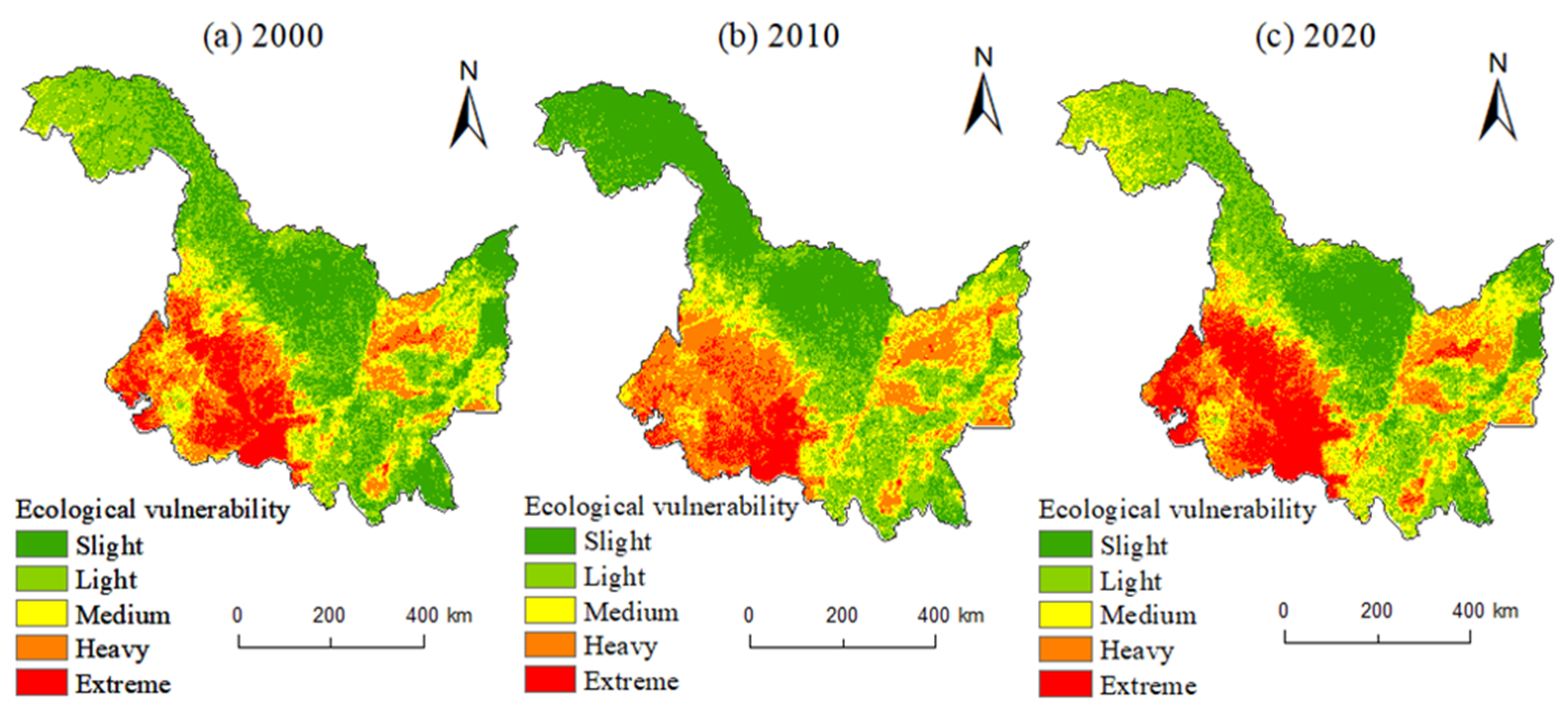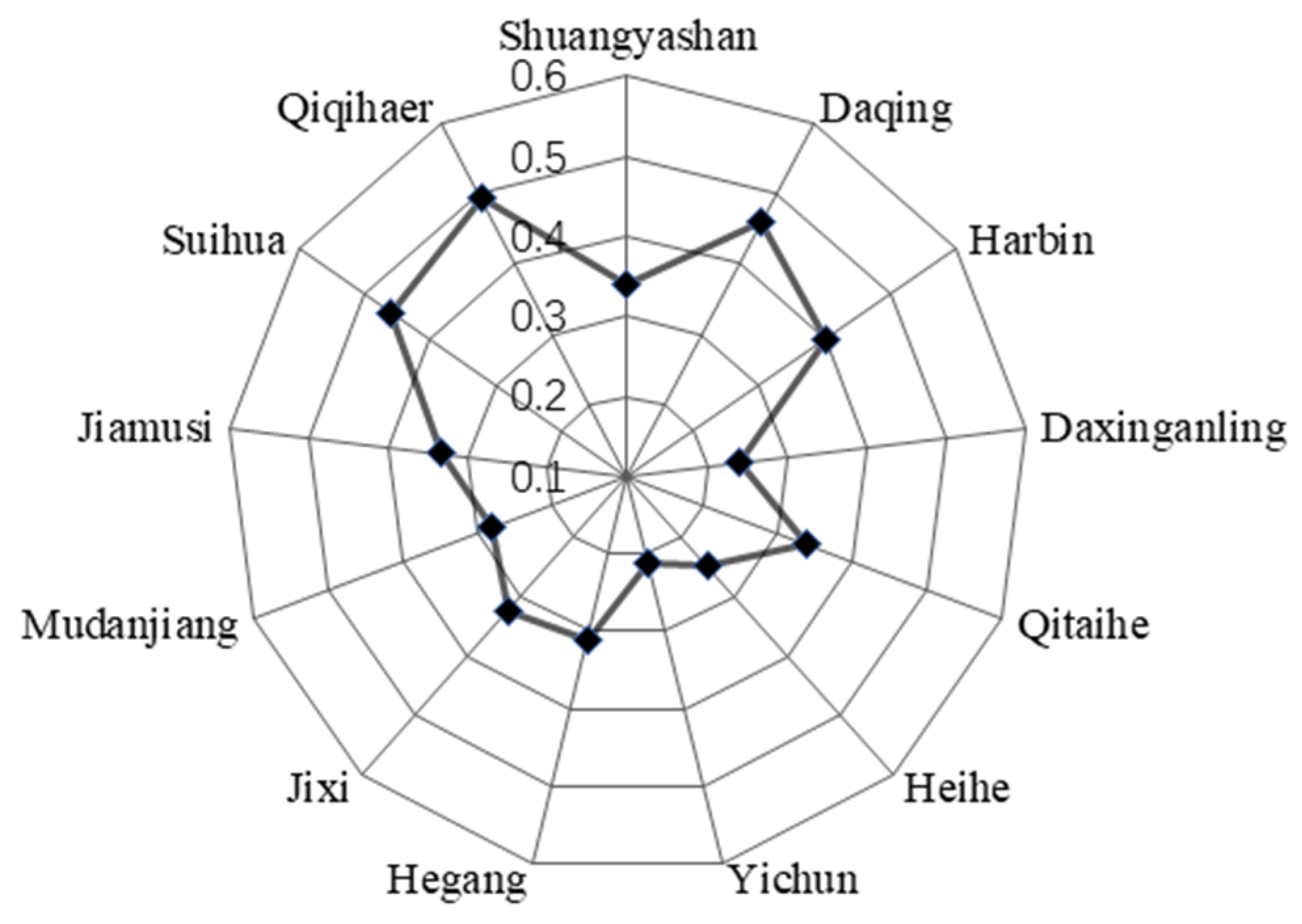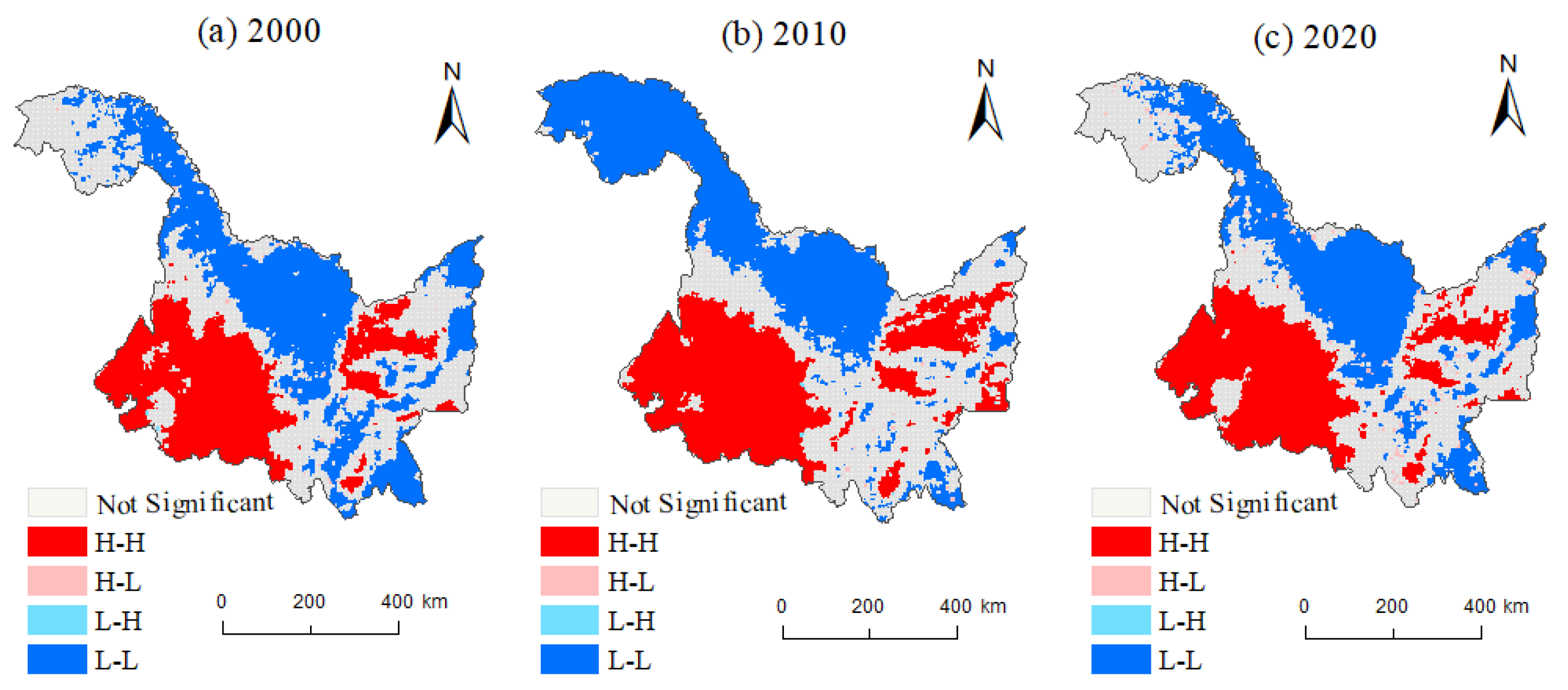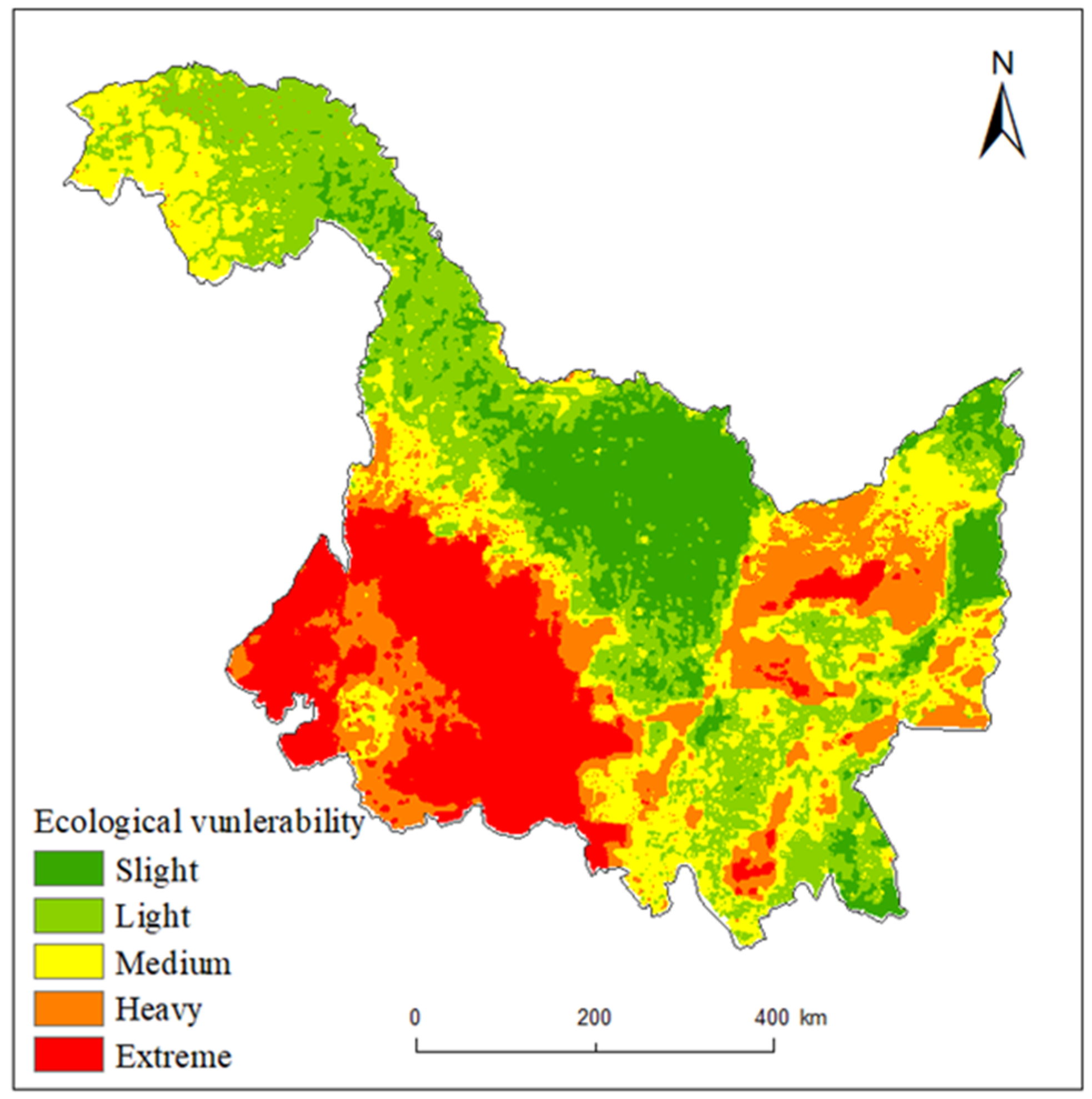Spatiotemporal Differentiation and Attribution Analysis of Ecological Vulnerability in Heilongjiang Province, China, 2000–2020
Abstract
1. Introduction
2. Materials and Methods
2.1. Study Area
2.2. Data Sources
2.3. Methodology
2.3.1. Selection of Evaluation Indicators
2.3.2. Index Standardization and the Determination of Weights
- (1)
- Index Standardization
- (2)
- Determination of Weights
2.3.3. Integrated Ecological Vulnerability Assessment
2.3.4. Spatial Autocorrelation
2.3.5. GeoDetector
2.3.6. CA-Markov Model
3. Results
3.1. Features of Heilongjiang Province’s Ecological Vulnerability Changes over Time
3.2. Features of Ecological Vulnerability’s Spatial Distribution
3.3. Analysis of Ecological Vulnerability via Spatial Correlation
3.4. Driving Factor Analysis
3.5. CA-Markov Predictive Analytics
4. Discussion
5. Conclusions
- (1)
- The total ecological vulnerability of Heilongjiang Province remained at a moderate level between 2000 and 2020, showing a trend of first slowing down and then growing. The distribution was “high in the east and west, low in the north and south.” At the municipal level, Daxing’anling, Heihe, Mudanjiang, and Hegang were categorized as less than moderately vulnerable, but Shuangyashan, Qitaihe, Harbin, Jixi, and Jiamusi showed moderate ecological sensitivity. Suihua, Qiqihar, and Daqing, on the other hand, displayed ecological vulnerability levels that were greater than moderate. This finding provides a scientific foundation for regional ecological management and protection by highlighting the variations in ecological vulnerability across Heilongjiang Province’s various regions.
- (2)
- Heilongjiang Province’s ecological vulnerability has notable spatial clustering features, mostly consisting of low-low and high-high clustering regions. While the low-low clustering areas are mostly found in locations with good natural conditions, such as moderate and lightly sensitive zones, the high-high clustering areas are predominantly found in severely and extremely vulnerable regions with strong human activity. The regional distribution of ecological vulnerability during the relevant period is consistent with these tendencies. The temporal and spatial stability of vulnerability distribution is further supported by the spatial distribution characteristics, which align with the patterns of ecological vulnerability changes over time.
- (3)
- Numerous factors impact Heilongjiang Province’s ecological vulnerability’s spatial distribution characteristics. The four most significant factors affecting the study area are biological abundance, net primary productivity, dryness, and PM2.5. Moreover, the highest interactions between these factors occurred in different years when they were combined. This highlights the importance of ecological complexity and the interaction of multiple factors, suggesting that future ecological protection efforts should consider the synergistic effects of various factors.
- (4)
- Ecological vulnerability can be predicted using the CA-Markov model. By 2030, Heilongjiang Province’s total ecological vulnerability is predicted to rise, with a greater proportion of regions having severe and extreme vulnerability and a decrease in the proportion of regions with low and moderate vulnerability. In addition to creating more focused and targeted ecological protection measures, relevant authorities should focus more on high-vulnerability areas, especially the extremely susceptible areas in the province’s west and south.
Author Contributions
Funding
Institutional Review Board Statement
Informed Consent Statement
Data Availability Statement
Conflicts of Interest
References
- Tang, Q.; Wang, J.M.; Jing, Z.R.; Yan, Y.L.; Niu, H.B. Response of ecological vulnerability to land use change in a resource-based city, China. Resour. Policy 2021, 74, 102324. [Google Scholar] [CrossRef]
- Xue, L.Q.; Wang, J.; Zhang, L.C.; Wei, G.H.; Zhu, B.L. Spatiotemporal analysis of ecological vulnerability and management in the Tarim River Basin, China. Sci. Total Environ. 2018, 649, 876–888. [Google Scholar] [CrossRef] [PubMed]
- Wu, X.L.; Tang, S.Y. Comprehensive evaluation of ecological vulnerability based on the AHP-CV method and SOM model: A case study of Badong County, China. Ecol. Indic. 2022, 137, 108758. [Google Scholar] [CrossRef]
- Kumar, P.; Gupta, S.; Dagar, V. Sustainable energy development through non- residential rooftop solar photovoltaic adoption: Empirical evidence from India. Sustain. Dev. 2024, 32, 795–814. [Google Scholar] [CrossRef]
- Kumar, P.; Pandey, R.; Fürst, C.; Joshi, P.K. The role of information infrastructure for climate change adaptation in the socio-ecological system of the Central Himalaya: Availability, utility, and gaps. Socio Ecol. Pract. Res. 2021, 3, 397–410. [Google Scholar] [CrossRef]
- Wang, P.; Zhao, W.; Ke, X.L. Evaluation and Spatiaotemporal Evolution of Ecological Vulnerability of Qianjiang Based on SRP Model. Res. Soil. Water Conserv. 2021, 28, 347–354. [Google Scholar]
- Wang, Y.; Li, X.M.; Zhang, F.; Wang, W.W.; Xiao, R.B. Effects of rapid urbanization on ecological functional vulnerability of the land system in Wuhan, China: A flow and stock perspective. J. Clean. Prod. 2020, 248, 119284. [Google Scholar] [CrossRef]
- Wolters, M.L.; Sun, Z.; Huang, C.; Kuenzer, C. Environmental awareness and vulnerability in the Yellow River Delta: Results based on a comprehensive household survey. Ocean Coast. Manag. 2016, 120, 1–10. [Google Scholar] [CrossRef]
- Srinurak, N.; Wonglangka, W.; Sukwai, J. Smart Urban Forest Initiative: Nature-Based Solution and People-Centered Approach for Tree Management in Chiang Mai, Thailand. Sustainability 2024, 16, 11078. [Google Scholar] [CrossRef]
- Jackson, L.E.; Bird, S.L.; Matheny, R.W.; O’Neill, R.V.; White, D.; Boesch, K.C.; Koviach, J.L. A regional approach to projecting land-use change and resulting ecological vulnerability. Environ. Monit. Assess. 2004, 94, 231–248. [Google Scholar] [CrossRef]
- He, L.; Shen, J.; Zhang, Y. Ecological vulnerability assessment for ecological conservation and environmental management. J. Environ. Manag. 2018, 206, 1115–1125. [Google Scholar] [CrossRef] [PubMed]
- Beroya-Eitner, M.A. Ecological vulnerability indicators. Ecol. Indic. 2016, 60, 329–334. [Google Scholar] [CrossRef]
- Qiu, B.K.; Li, H.L.; Zhou, M.; Zhang, L. Vulnerability of ecosystem services provisioning to urbanization: A case of China. Ecol. Indic. 2015, 57, 505–513. [Google Scholar] [CrossRef]
- Zheng, H.L.; Wang, Y.H.; Ma, W. Evaluation of Eco-environmental Vulnerability of Pearl River Delta Based on PSR Mode. Bull. Soil. Water Conserv. 2022, 42, 210–217+381. [Google Scholar]
- Niemeijer, D.; Groot, R.S. Framing environmental indicators: Moving from causal chains to causal networks. Environ. Dev. Sustain. 2008, 10, 89–106. [Google Scholar] [CrossRef]
- Jiang, B.H.; Chen, W.; Dai, X.A.; Xu, M.; Liu, L.F.; Sakai, T.; Li, S.L. Change of the spatial and temporal pattern of ecological vulnerability: A case study on Cheng-Yu urban agglomeration, Southwest China. Ecol. Indic. 2023, 149, 110161. [Google Scholar] [CrossRef]
- Alwan, I.A.; Aziz, N.A. Monitoring of surface ecological change using remote sensing technique over Al-Hawizeh Marsh, Southern Iraq. Remote Sens. Appl. Soc. Environ. 2022, 27, 100784. [Google Scholar] [CrossRef]
- Robielos, R.A.C.; Lin, C.J.; Senoro, D.B.; Ney, F.P. Development of vulnerability assessment framework for disaster risk reduc tion at three levels of geopolitical units in the Philippines. Sustainability 2020, 12, 8815. [Google Scholar] [CrossRef]
- Li, J.W.; Yuan, Y.T.; Zhang, Y.; Liu, M. Study on the Spatial Pattern and Zoning of Ecological Vulnerability in Island and Territorial Waters Based on VSD Model—A Case Study of Juehua Island. Sustainability 2024, 16, 10452. [Google Scholar] [CrossRef]
- Dinda, S.; Chatterjee, N.D.; Ghosh, S. Modelling the future vulnerability of urban green space for priority-based management and green prosperity strategy planning in Kolkata, India: A PSR-based analysis using AHP-FCE and ANN-Markov model. Geocarto Int. 2022, 37, 6551–6578. [Google Scholar] [CrossRef]
- Liu, X.W.; Zhou, H.C.; Li, P. A conceptual analysis of ecosystem stability. Acta Ecol. Sin. 2004, 24, 2635–2640. [Google Scholar]
- Song, G.; Li, Z.; Yang, Y.; Semakula, H.M.; Zhang, S. Assessment of ecological vulnerability and decision-making application for prioritizing roadside ecological restoration: A method combining geographic information system, Delphi survey and Monte Carlo simulation. Ecol. Ind. 2015, 52, 57–65. [Google Scholar] [CrossRef]
- Park, Y.S.; Chon, T.S.; Kwak, I.S.; Lek, S. Hierarchical community classification and assessment of aquatic ecosystems using artificial neural networks. Sci. Total Environ. 2004, 327, 105–122. [Google Scholar] [CrossRef]
- Nguyen, A.K.; Liou, Y.A.; Li, M.H.; Tran, T.A. Zoning eco-environmental vulnerability for environmental management and protection. Ecol. Indic. 2016, 69, 100–117. [Google Scholar] [CrossRef]
- Teng, Y.; Zhan, J.; Liu, S.; Agyemanga, F.B.; Li, Z.; Wang, C.; Liu, W. Integrating ecological and social vulnerability assessment in Qinghai Province, China. Phys. Chem. Earth 2022, 126, 103115. [Google Scholar] [CrossRef]
- Sun, Z.; Liu, Y.; Sang, H. Spatial-Temporal Variation and Driving Factors of Ecological Vulnerability in Nansi Lake Basin, China. Int. J. Environ. Res. Public Health 2023, 20, 2653. [Google Scholar] [CrossRef]
- Kamran, M.; Yamamoto, K. Analysis and visualization of spatio-temporal variations of ecological vulnerability in Pakistan using satellite observation datasets. Environ. Sustain. Indic. 2024, 23, 100425. [Google Scholar] [CrossRef]
- Furlan, A.; Bonotto, D.M.; Gumiere, S.J. Development of environmental and natural vulnerability maps for Brazilian coastal at Sao Sebastiao in Sao Paulo State. Environ. Earth Sci. 2011, 64, 659–669. [Google Scholar] [CrossRef]
- Luo, N.; He, M.; Gao, H. Comprehensive evaluation method for a distribution network based on improved AHP-CRITIC combination weighting and an extension evaluation model. Power Syst. Prot. Control 2021, 49, 86–96. [Google Scholar]
- Ru, S.F.; Ma, R.H. Evaluation, spatial analysis and prediction of ecological environment vulnerability of Yellow River Basin. J. Nat. Resour. 2022, 37, 1722–1734. [Google Scholar] [CrossRef]
- Wu, H.W.; Guo, B.; Fan, J.F.; Yang, F.; Han, B.M.; Wei, C.X.; Lu, Y.F.; Zang, W.Q.; Zhen, X.Y.; Meng, C. A novel remote sensing ecological vulnerability index on large scale: A case. Ecol. Indic. 2021, 129, 107955. [Google Scholar] [CrossRef]
- Weng, C.Y.; Bai, Y.P.; Chen, B.H.; Hu, Y.C.; Shu, J.Y.; Chen, Q.; Wang, P. Assessing the vulnerability to climate change of a semi-arid pastoral social–ecological system: A case study in Hulunbuir, China. Ecol. Inf. 2023, 76, 102139. [Google Scholar] [CrossRef]
- Raj, A.; Sharma, L.K. Spatial E-PSR modelling for ecological sensitivity assessment for arid rangeland resilience and management. Ecol. Model. 2023, 478, 110283. [Google Scholar] [CrossRef]
- Afrin, R.; Sultana, R.; Alam, M.S. A Comprehensive analysis of drought vulnerability in the Barind region of Bangladesh: A socio-ecological systems approach. Ecol. Indic. 2024, 160, 111863. [Google Scholar] [CrossRef]
- Buxton, M.; Haynes, R.; Mercer, D.; Butt, A. Vulnerability to Bushfire Risk at Melbourne’s Urban Fringe: The Failure of Regulatory Land Use Planning. Geogr. Res. 2011, 49, 1–12. [Google Scholar] [CrossRef]
- Gupta, A.K.; Nandy, S.; Nath, A.J.; Mehta, D.; Pandey, R. Spatially Explicit climate change vulnerability assessment of ecological systems along altitudinal gradients in the Indian Himalayan region. Environ. Sustain. Indic. 2024, 22, 10037. [Google Scholar] [CrossRef]
- Nandy, S.; Singh, C.; Das, K.K.; Kingma, N.C.; Kushwaha, S.P.S. Environmental vulnerability assessment of eco-development zone of Great Himalayan National Park, Himachal Pradesh, India. Ecol. Indic. 2015, 57, 182–195. [Google Scholar] [CrossRef]
- Xu, X.N.; Yang, Q.W.; Xiang, G.P.; Liu, T.; Yang, M.J.; Xiong, X.; Jiang, T. Comprehensive evaluation of the Ruoergai Prairie ecosystem upstream of the Yellow River. Ecol. Evol. 2022, 10, 1047896. [Google Scholar] [CrossRef]
- Li, J. An Assessment of Ecological Protection Importance Based on Ecosystems Services and Vulnerabilities in Tibet, China. Sustainability 2022, 14, 12902. [Google Scholar] [CrossRef]
- Hua, T.; Zhao, W.W.; Cherubini, F.; Hu, X.P.; Pereira, P. Sensitivity and future exposure of ecosystem services to climate change on the Tibetan Plateau of China. Landsc. Ecol. 2021, 36, 3451–3471. [Google Scholar] [CrossRef]
- Guo, B.; Zang, W.Q.; Luo, W. Spatial-temporal shifts of ecological vulnerability of Karst Mountain ecosystem-impacts of global change and anthropogenic interference. Sci. Total Environ. 2020, 742, 140256. [Google Scholar] [CrossRef] [PubMed]
- Chen, Y.; Xiong, K.; Ren, X.; Cheng, C. Vulnerability Comparison between Karst and Non-Karst Nature Reserves—With a Special Reference to Guizhou Province, China. Sustainability 2021, 13, 2442. [Google Scholar] [CrossRef]
- Ghosh, S.; Das, A. Urban expansion induced vulnerability assessment of East Kolkata Wetland using Fuzzy MCDM method. Remote Sens. Appl. Soc. Environ. 2019, 13, 191–203. [Google Scholar] [CrossRef]
- Bourgoin, C.; Oszwald, J.; Bourgoin, J.; Gond, V.; Blanc, L.; Dessard, H.; Phan, T.V.; Sist, P.; Läderach, P.; Reymondin, L. Assessing the ecological vulnerability of forest landscape to agricultural frontier expansion in the Central Highlands of Vietnam. Int. J. Appl. Earth Obs. Geoinf. 2020, 84, 101958. [Google Scholar] [CrossRef]
- Fornaciari, M.; Muscas, D.; Rossi, F.; Filipponi, M.; Castellani, B.; Giuseppe, A.D.; Proietti, C.; Ruga, L.; Orlandi, F. CO2 Emission Compensation by Tree Species in Some Urban Green Areas. Sustainability 2024, 16, 3515. [Google Scholar] [CrossRef]
- Quan, W.T.; Zhang, S.Y.; Liu, Y. Monitoring and Evaluation of Ecological Environment Changes in Dongzhuang Reservoir Basin in Shaanxi Province Based on Remote Sensing Ecological Index. Bull. Soil. Water Conserv. 2022, 42, 96–104+113. [Google Scholar]
- Chen, X.H.; Gu, Y.; Pan, W. The coordinated development characteristics and dynamic response mechanism of defense-absorption-renewal of rural resilience system in Heilongjiang Province, China. Acta Ecol. Sin. 2024, 44, 6976–6988. [Google Scholar]
- Ma, L.X.; Kang, H.; He, D.; Liu, J.W.; Tang, H.J.; Wu, S.Q.; Li, X.X. The evolution process of ecological vulnerability and its quantitative analysis of influencing factors: A case study of Longdong area. Environ. Sci. Pollut. Res. Int. 2023, 30, 51464–51490. [Google Scholar] [CrossRef]
- Cai, X.; Li, Z.; Liang, Y. Temporal changes of ecological vulnerability in the arid area based on ordered weighted average model. Ecol. Indic. 2021, 133, 108398. [Google Scholar] [CrossRef]
- Liu, Y.M.; Yang, S.N.; Han, C.L.; Ni, W.; Zhu, Y.Y. Variability in regional ecological vulnerability: A case study of Sichuan Province, China. Int. J. Disaster Risk Sci. 2020, 11, 696–708. [Google Scholar] [CrossRef]
- Qiao, Q.; Gao, J.X.; Wang, W.; Tian, M.R.; Lv, S.H. Method and application of ecological frangibility assessment. Res. Environ. Sci. 2008, 21, 117–123. [Google Scholar]
- Hou, K.; Li, X.; Wang, J.; Zhang, J. Evaluating Ecological Vulnerability Using the GIS and Analytic Hierarchy Process (AHP) Method in Yan’an, China. Pol. J. Environ. Stud. 2016, 25, 599–605. [Google Scholar]
- Diakoulaki, D.; Mavrotas, G.; Papayannakis, L. Determining objective weights in multiple criteria problems: The critic method. Comput. Oper. Res. 1995, 22, 763–770. [Google Scholar] [CrossRef]
- Zou, T.H.; Chang, Y.X.; Chen, P. Evaluation of eco-environmental vulnerability in Jilin Province based on an AHP-PCA entropy weight model. Chin. J. Eco-Agric. 2023, 31, 1511–1524. [Google Scholar]
- Tang, L.; Hu, X.J.; Luo, Z.W.; Wei, B.J.; Wang, Y.Z.; Zhang, Y.L.; Shao, R.Y.; Chen, C.Y. Spatiotemporal coupling of ecological vulnerability and urbanization level and their interactive influencing factors: A case study of Hunan province. Acta Ecol. Sin. 2024, 44, 4662–4677. [Google Scholar]
- Tang, Q.; Wang, J.; Jing, Z. Tempo-spatial changes of ecological vulnerability in resource-based urban based on genetic projection pursuit model. Ecol. Ind. 2021, 121, 107059. [Google Scholar] [CrossRef]
- Darand, M.; Dostkamyan, M.; Rehmani, M.I.A. Spatial Autocorrelation Analysis of Extreme Precipitation in Iran. Russ. Meteorol. Hydrol. 2017, 42, 415–424. [Google Scholar] [CrossRef]
- Zhang, C.; Lv, W.Y.; Zhang, P.; Song, J.C. Multidimensional spatial autocorrelation analysis and it’s application based on improved Moran’s I. Earth Sci. Inform. 2023, 16, 3355–3368. [Google Scholar] [CrossRef]
- Batlle, J.R.M.; Van Der Hoek, Y. Clusters of High Abundance of Plants Detected from Local Indicators of Spatial Association (LISA) in a semi-deciduous tropical forest. PLoS ONE 2018, 13, e0208780. [Google Scholar]
- Ding, Q.; Shi, X.; Zhuang, D.; Wang, Y. Temporal and Spatial Distributions of Ecological Vulnerability under the Influence of Natural and Anthropogenic Factors in an Eco-Province under Construction in China. Sustainability 2018, 10, 3087. [Google Scholar] [CrossRef]
- Jing, H.C.; Liu, Y.H.; He, P. Spatial Heterogeneity of Ecosystem Services and Its Influencing Factors in Typical Areas of the Qinghai-Tibet Plateau: A Case Study of Nagqu City. Acta Ecol. Sin. 2022, 42, 2657–2673. [Google Scholar]
- Wang, J.F.; Xu, C.D. Geodetector: Principle and prospective. Acta Geogr. Sin. 2017, 72, 116–134. [Google Scholar]
- Wang, Y.Q.; Yao, S.B.; Hou, M.Y. Spatial-temporal differentiation and its influencing factors of agricultural eco-efficiency in China based on geographic detector. Chin. J. Appl. Ecol. 2021, 32, 4039–4049. [Google Scholar]
- Gu, H.; Huan, C.; Yang, F. Spatiotemporal Dynamics of Ecological Vulnerability and Its Influencing Factors in Shenyang City of China: Based on SRP Model. Int. J. Environ. Res. Public. Health 2023, 20, 1525. [Google Scholar] [CrossRef]
- Liu, F.; Qin, T.L.; Girma, A.; Wang, H.; Weng, B.S.; Yu, Z.L.; Wang, Z.L. Dynamics of Land-Use and vegetation Change Using NDVI and Transfer Matrix: A Case Study of the Huaihe River Basin. Pol. J. Environ. Stud. 2018, 28, 213–223. [Google Scholar] [CrossRef]
- Wang, H.R. Study on the Development of Forest Ecotourism in Greater Khingan Mountains of Heilongjiang Province. Northen Hortic. 2019, 21, 165–170. [Google Scholar]
- Xue, Y.H. Study on the Measurement and Influencing Factors of Green Development Level of Tourism Industry in Heilongjiang Province. Master’s Thesis, Harbin University of Commerce, Harbin, China, 2022. [Google Scholar]
- Zhang, T.; Hu, Y.Z.; Hu, H.H.; Lei, T.T. Prediction of Land Use and Habitat Quality in Harbin City Based on the PLUS- InVEST Model. Environ. Sci. 2024, 45, 4709–4721. [Google Scholar]
- Zhan, H.L.; Wang, W.G.; Wang, J.; Zhao, X.J.; Bo, Y.L.; Hou, Y.J. Analysis on evolution of ecological vulnerability of Shanxi Province based on the remote sensing and GIS technique. Remote Sens. Technol. Appl. 2024, 39, 478–491. [Google Scholar]








| Datatypes | Source | Resolution/m | Use |
|---|---|---|---|
| Topographic data | Resource and Environmental Science Data Platform (https://www.resdc.cn/) (accessed on 15 February 2024) | 90 m | Obtain elevation, slope |
| Meteorological data | National Earth System Science Data Center (http://www.geodata.cn/) (accessed on 15 February 2024) | 1 km | Obtain annual average temperature, annual precipitation, dry degree |
| Land use data | Resource and Environmental Science Data Platform (https://www.resdc.cn/) (accessed on 15 February 2024) | 30 m | Obtain degree of land use, biological abundance, landscape diversity indices |
| Remote sensing data | NASA (https://www.nasa.gov/) (accessed on 15 February 2024) | 1 km | Obtain NDVI, net primary productivity |
| Socioeconomic data | WorldPop (https://www.worldpop.org/) (accessed on 15 February 2024) | - | Obtain population density |
| Heilongjiang Statistical Yearbook | - | Obtain GDP per capita | |
| Other data | CHAP (https://data.tpdc.ac.cn/) (accessed on 15 February 2024) | 1 km | Obtain PM2.5 |
| Standard | Element | Factor | Nature of the Indicator |
|---|---|---|---|
| Sensitivity | Topographic factor | Elevation (X1) Slope (X2) | + + |
| Meteorological factor | Annual average temperature (X3) Annual precipitation (X4) PM2.5 (X5) Dry degree (X6) | + − + + | |
| Resilience | Eco-vitality factors | Landscape diversity (X7) NDVI (X8) Biological abundance (X9) Net primary productivity (X10) | − − − − |
| Pressure | Anthropogenic stress factors | Population density (X11) GDP per capita (X12) | + + |
| Clustering Types | Connotation |
|---|---|
| High-high clustering (H-H) | Characteristics of spatial clustering where both the region and the surrounding regions have a fair amount of ecological risk. |
| High-low clustering (H-L) | Features of spatial clustering when the surrounding area’s ecological vulnerability is low, and the region’s is high. |
| Low-high clustering (L-H) | Features of spatial clustering where the ecological sensitivity of the surrounding area is great but that of the region is minimal. |
| Low-low clustering (L-L) | Characteristics of spatial clustering where both the region and the surrounding area have comparatively low ecological vulnerability. |
| Not significant | No significant spatial clustering characteristics. |
| Source for Judging | Interaction Type |
|---|---|
| q(X1∩X2) < Min[q(X1),q(X2)] | Weakened, non-linear |
| Min[q(X1),q(X2)] < q(X1∩X2) < Max[q(X1),q(X2)] | Weakened, single factor non-linear |
| q(X1∩X2) > Max[q(X1),q(X2)] | Enhanced, double factors |
| q(X1∩X2) = q(X1) + q(X2) | Independent |
| q(X1∩X2) > q(X1) + q(X2) | Enhanced, non-linear |
| Level of Vulnerability | 2000 | 2010 | 2020 | |||
|---|---|---|---|---|---|---|
| Area/km2 | Percentage/% | Area/km2 | Percentage/% | Area/km2 | Percentage/% | |
| Slight vulnerability | 118,463 | 27.04 | 142,884 | 32.61 | 92,439 | 21.1 |
| Light vulnerability | 130,248 | 29.73 | 89,835 | 20.5 | 120,293 | 27.46 |
| Medium vulnerability | 75,469 | 17.22 | 76,714 | 17.51 | 88,887 | 20.29 |
| Heavy vulnerability | 66,386 | 15.15 | 95,008 | 21.68 | 66,728 | 15.23 |
| Extreme vulnerability | 47,609 | 10.87 | 33,736 | 7.7 | 69,749 | 15.92 |
| Driving Factor | q-Value | Mean q-Value | Ranking of Mean q-Values | ||
|---|---|---|---|---|---|
| 2000 | 2010 | 2020 | |||
| Elevation | 0.291 | 0.42 | 0.285 | 0.332 | 6 |
| Slope | 0.245 | 0.3 | 0.238 | 0.261 | 8 |
| Annual average temperature | 0.275 | 0.433 | 0.331 | 0.346 | 5 |
| Annual precipitation | 0.245 | 0.148 | 0.143 | 0.178 | 10 |
| PM2.5 | 0.46 | 0.598 | 0.516 | 0.525 | 4 |
| Dry degree | 0.558 | 0.597 | 0.486 | 0.547 | 3 |
| Landscape diversity | 0.064 | 0.073 | 0.07 | 0.069 | 13 |
| NDVI | 0.388 | 0.206 | 0.146 | 0.247 | 9 |
| Biological abundance | 0.586 | 0.625 | 0.561 | 0.591 | 1 |
| Net primary productivity | 0.515 | 0.652 | 0.58 | 0.583 | 2 |
| Population density | 0.049 | 0.12 | 0.047 | 0.072 | 12 |
| GDP per capita | 0.049 | 0.085 | 0.117 | 0.084 | 11 |
| Degree of land use | 0.329 | 0.326 | 0.281 | 0.312 | 7 |
Disclaimer/Publisher’s Note: The statements, opinions and data contained in all publications are solely those of the individual author(s) and contributor(s) and not of MDPI and/or the editor(s). MDPI and/or the editor(s) disclaim responsibility for any injury to people or property resulting from any ideas, methods, instructions or products referred to in the content. |
© 2025 by the authors. Licensee MDPI, Basel, Switzerland. This article is an open access article distributed under the terms and conditions of the Creative Commons Attribution (CC BY) license (https://creativecommons.org/licenses/by/4.0/).
Share and Cite
Li, Y.; Liu, J.; Zhu, Y.; Wu, C.; Zhang, Y. Spatiotemporal Differentiation and Attribution Analysis of Ecological Vulnerability in Heilongjiang Province, China, 2000–2020. Sustainability 2025, 17, 2239. https://doi.org/10.3390/su17052239
Li Y, Liu J, Zhu Y, Wu C, Zhang Y. Spatiotemporal Differentiation and Attribution Analysis of Ecological Vulnerability in Heilongjiang Province, China, 2000–2020. Sustainability. 2025; 17(5):2239. https://doi.org/10.3390/su17052239
Chicago/Turabian StyleLi, Yang, Jiafu Liu, Yue Zhu, Chunyan Wu, and Yuqi Zhang. 2025. "Spatiotemporal Differentiation and Attribution Analysis of Ecological Vulnerability in Heilongjiang Province, China, 2000–2020" Sustainability 17, no. 5: 2239. https://doi.org/10.3390/su17052239
APA StyleLi, Y., Liu, J., Zhu, Y., Wu, C., & Zhang, Y. (2025). Spatiotemporal Differentiation and Attribution Analysis of Ecological Vulnerability in Heilongjiang Province, China, 2000–2020. Sustainability, 17(5), 2239. https://doi.org/10.3390/su17052239





